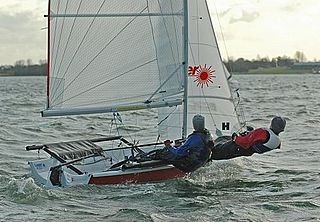Related Research Articles

A dinghy is a type of small boat, often carried or towed by a larger vessel for use as a lifeboat or tender. Utility dinghies are usually rowboats or have an outboard motor. Some are rigged for sailing but they differ from sailing dinghies, which are designed first and foremost for sailing. A dinghy's main use is for transfers from larger boats, especially when the larger boat cannot dock at a suitably-sized port or marina.

Dinghy sailing is the activity of sailing small boats by using five essential controls:

The GP14 is a popular sailing dinghy, with well over 14,000 built.

The Laser is a highly popular family of small one-design sailing dinghies using the same common hull and interchangeable rigs with different sail areas. The Laser is designed to be sailed single-handed although class rules permit two sailors. Bruce Kirby designed the Laser in 1970 with an emphasis on simplicity and performance.
The Portsmouth Yardstick (PY) or Portsmouth handicap scheme is a term used for a number of related systems of empirical handicapping used primarily in small sailboat racing.

The Wayfarer is a wooden or fibreglass hulled fractional Bermuda rigged sailing dinghy of great versatility; used for short 'day boat' trips, longer cruises and for racing. Over 11,000 have been produced as of 2016.

The Optimist, also known as the ‘opti’, 'oppie', 'opy' or 'bathtub' is a small, single-handed sailing dinghy intended for use by children up to the age of 15. Contemporary boats are usually made of fibreglass, although wooden boats are still built.

The Byte is a small one-design sailing dinghy sailed by one person. It was designed by Canadian Ian Bruce, who also commissioned and marketed the Laser.

The Fireball is a British sailing dinghy that was designed by Peter Milne as a one-design racer and first built in 1962.

The Laser 4000 is a racing dinghy crewed by two persons. Its one-design weight-equalised system enables physically differing sailors to compete on a level playing field. It is most popular in Europe, particularly the UK, France and Italy.

The Wanderer is a 14-foot Fibreglass hull Bermuda rigged sailing dinghy designed by Ian Proctor. One of the main objectives of the design was to produce a robust safe and versatile dinghy that could be used for knockabout day sailing and cruising as well as racing, but was light enough to be handled ashore.
The Pacer class of sailing dinghy, formerly known as the Puffin Pacer, was designed in the United Kingdom by Jack Holt. It was commissioned by Puffin Paints and Glues to be designed as sailing dinghy for use by families, so needing to be larger than their earlier Puffin dinghy. It has since become a popular learning and racing dinghy in Australia, Canada, the Netherlands, India and the UK. The name was changed in the UK early 1970s, although Australia continued to use the name until 1989, when they followed the UK in dropping the "puffin" and chose the wedge-tailed shearwater as the boat's symbol.
The RS Vareo is a modern, single-handed sailing dinghy raced throughout the UK at both club and national level. The RS Vareo is a hiking singlehander with an asymmetric spinnaker.

The Bermuda Fitted Dinghy is a type of racing-dedicated sail boat used for competitions between the yacht clubs of Bermuda. Although the class has only existed for about 130 years, the boats are a continuance of a tradition of boat and ship design in Bermuda that stretches back to the earliest decades of the 17th century.
The Miracle is a small dinghy sailboat popularized in the United Kingdom, and designed by Jack Holt — one of the last for the well-known designer.

The Laser Vago is a British/American sailing dinghy that was designed by Jo Richards as a one-design racer and first built in 2005.

The Gull sailing dinghy was designed by Ian Proctor in 1956, originally as a frameless double-chine plywood boat. However, it has been through several incarnations: the wooden Mark I, GRP Mark III, GRP Gull Spirit and GRP Gull Calypso. Today it is popular with sailing schools, especially in the UK.
The RS700 is a single-handed racing dinghy built by RS Sailing and designed in 2000 by Nick Peters and Alex Southon as part of the RS series and built in 2001. It is raced in many sailing clubs around Britain, with a PY number of 850 and a D-PN of 73.3.
The 12' Dinghy was a sailing event on the Sailing at the 1928 Summer Olympics program in Amsterdam. A combination of Preliminary series and final series were scheduled. 23 sailors from 20 nations competed on twelve 12' Dinghies that were supplied by the Royal Dutch Yachting Union (Koninklijke Verbonden Nederlandsche Watersport Vereenigingen).
ISO is a former International Sailing Federation (ISAF) class of two-person sailing dinghy with a single trapeze and an asymmetric spinnaker. The ISO was designed in 1993 by Ian Howlett and John Caig and manufactured by Reg White Limited of Brightlingsea as part of the "White Formula" range of boats originally marketed by Topper International Ltd and since 2013 by Vantage Sailing Ltd. The boat has a fully battened mainsail, jib and an asymmetric spinnaker.
References
- ↑ "RYA Portsmouth Yardstick List 2010" (PDF). Royal Yachting Association. Archived from the original (PDF) on 25 May 2013. Retrieved 21 August 2012.
| | This article about a type of ship or boat is a stub. You can help Wikipedia by expanding it. |